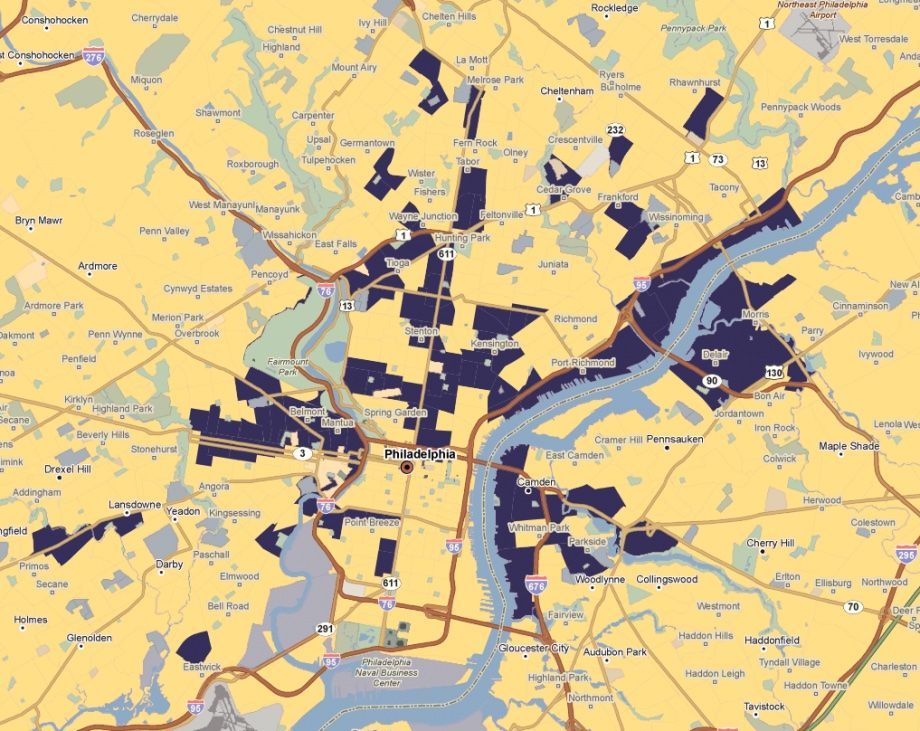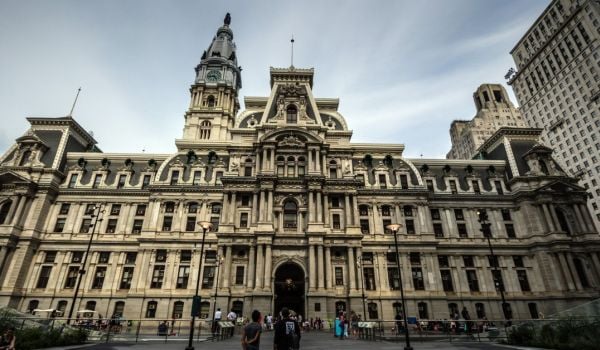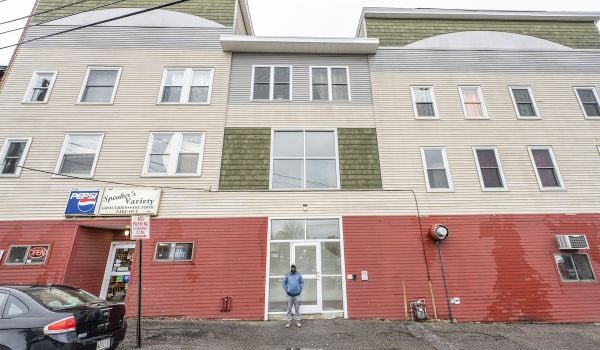Della Clark has been working against long odds for basically her entire life. For the past three decades, she’s been president and CEO of The Enterprise Center, a nonprofit that supports small and mid-sized businesses in low-income communities throughout the Philadelphia region — a region where, despite 41 percent of the population being black, only 2.5 percent of businesses are black-owned.
Opportunity Zones, the new federal tax break for investing in areas defined as economically distressed, have been billed as a way to shorten the odds for businesses in low-income communities. When the U.S. Treasury confirmed the map of 8,762 census tracts designated as Opportunity Zones last year, Clark found many of her organizations’ clients in the Philly region were already located in those tracts. But it was far from certain that the new investors drawn by the Opportunity Zone designation would care about any of the thousands of small and mid-sized business owners who have walked through The Enterprise Center’s doors in West Philadelphia over the past 30 years.
With no dollar limit, few restrictions, and no public reporting requirements in the legislation that created them, Opportunity Zones have the potential to be a multi-trillion dollar land grab for investors, displacing many of the 35 million people who live in those census tracts — a majority of whom are people of color. The likes of former Trump aide Anthony Scaramucci are among those planning to use the tax break. Investigative journalists are already discovering projects that don’t need the help but could still offer Opportunity Zone tax breaks to the wealthy. While Clark isn’t in position to stop those kinds of projects or investors, she remains optimistic that she can direct some of the dollars flowing into Opportunity Zones to her clients.
“I think you will have both in the marketplace — you’re going to have investors just concerned about their financial return, and there’s going to be other investors who are concerned about changing distressed communities into prosperous,” Clark says. “As trusted advisors, it’s going to be our role to weed out and find the ones that are more of a match for our clients.”
The odds remain long that Opportunity Zone investors are interested in businesses already operating in Opportunity Zones. Most Opportunity Zone investment dollars are already flowing toward real estate, as opposed to operating businesses. The math is easier — buy a property, make some improvements to it and eventually sell it to someone else for a higher price.
Starting last October, Clark has been criss-crossing the country attending Opportunity Zone gatherings to track down that small slice of Opportunity Zone investors who might be interested in putting money into operating businesses. She’s gone as far as New Orleans and Palo Alto, California, to meet potential investors or their financial advisors.
Meanwhile, back in Philly, Clark and her team have been working to compile a “dealbook,” consisting of one page, front-and-back investor-oriented summaries of a handful of businesses handpicked from their long list of current and previous clients.
But finding investors is only the beginning of the challenge. Clark, who is black, as are most of her clients, must also overcome any implicit racial bias that may exist in these predominantly white conference rooms. Opportunity Zone tax breaks apply only to capital gains income, meaning income derived from the sales of previous investments like stocks or real estate, or even works of art and other valuable assets. That means the tax breaks cater mostly to those who are already wealthy, and therefore largely white households — since the median white household has $40,000 in stocks and $78,500 in retirement accounts compared with $8,000 in stocks and mutual funds and $38,000 in retirement accounts for the median black household.
And regardless of whose money it is, asset management firms manage most financial assets. Out of $70 trillion managed by asset management firms registered in the U.S., less than one percent are managed by firms led by women or people of color, according to a 2017 report from the U.S. Government Accountability Office. Firms run largely by white men are the firms Clark is mostly encountering in the Opportunity Zone conferences she’s attending.
Under the legislation that created them as part of the 2017 Trump tax cuts, Opportunity Zone investments have to be in the form of equity — i.e. partial ownership shares — not debt. But equity capital historically been the least accessible to business owners of color. The rules, procedures and risks of taking on equity investors are vastly different than taking out a loan. If you’ve never done it before, it can take some reflection and soul-searching to get comfortable with it.
The first equity capital a business gets often comes from friends and family of the business owner. If you’re a white founder, the median net worth of your family and probably most of your friends is ten times the median net worth of the family and friends of a typical black founder. Therefore in most black communities, this kind of early-stage equity investment has simply never been a reliable option — until now, maybe. And that’s a big maybe.
“People are always interested in capital. The only thing that has been available to predominantly minority communities has been debt,” Clark says. “It’s sad to say we have to start a conversation about equity capital today when it should have been there already.”
It’s a tough conversation. Most equity investors are not friends and family, so bringing them in can mean bringing on someone new who starts looking over the founder or owner’s shoulder, someone who may not share the same values or have the same priorities. If the founder or owner isn’t careful up front, they may have given investors the power to fire them and hire a new CEO if the business isn’t performing as desired. Or investors may file a lawsuit to get their money back.
“I will typically spend at least three to five hours with a business owner before they even make the decision to go forward with raising capital this way,” says Clem Turner, a New York City-based attorney with two decades of experience counseling businesses and developers raising equity capital. “If they aren’t ready for it, it can be disastrous. I’ve had businesses opt not to go that route just because of the consequences if they weren’t able to deliver on their business plan.”
Not to mention conducting a legally compliant equity investment process is expensive, and Opportunity Zones provide no subsidy to anyone who might want to raise capital. It typically costs between $30,000-$40,000 to produce the documentation necessary for a legally compliant equity investment process, according to Turner. Mistakes on the documentation, known as a private placement memorandum, can lead to lawsuits from investors.
Turner says he has already worked on about a dozen Opportunity Zone investment transactions. Most of those deals have been for real estate projects, and most of the investors in those transactions were people who had prior investments with the developer now raising capital using Opportunity Zone tax breaks.
Many Opportunity investors won’t be investing directly into one project or one business. They will be putting their dollars into Opportunity Funds — intermediaries set up under the legislation to pool dollars and make multiple investments in Opportunity Zones. Real estate consulting firm Novogradac & Company currently lists 134 Opportunity Funds, representing more than $29 billion in investment capacity. Some of these intermediaries aim to focus on specific markets, but some seek to be national in scope, so they’re on Clark’s networking radar, too — but many of them are focused on real estate, not operating businesses.
The Enterprise Center itself has established an entity to serve as an Opportunity Fund, but it hasn’t raised any capital yet. Clark hopes they can raise at least $20 million.
Another barrier seems a long way off, but it has to be discussed before the investments actually happen: Cashing out. Equity investors will want their cash back with big returns, and the tax break is set up to reward the biggest returns. If you put $100,000 into an Opportunity Zone investment today and hold onto it for at least ten years, and eventually sell for $1 million, the $900,000 profit is tax-free income. Two kinds of investments can promise returns like that: real estate in a gentrifying neighborhood or a company that has a big initial public offering in its future. Not every Opportunity Zone business wants a big IPO. Clark says she hasn’t had to talk about that next investment phase yet, but it’s something she knows will come up in those conversations with investors.
Given all these challenges to navigate between potential Opportunity Zone investors and the businesses in Clark’s dealbook, she is careful to frame her goals around impact, hoping to go deeper than the number of businesses she helps get Opportunity Zone capital. For her, it’s also about the shift in mindset for minority-owned businesses that have been left out of the equity capital game for too long. Opportunity Zones may be gone in ten years, but equity capital markets will be there long after that. The new tax break has given Clark a moment to start that conversation with investors and her clients.
“It’s about getting our clients to understand they should be in the capital markets like anyone else and here’s your opportunity to get into it like never before,” Clark says.
UPDATE: This article was changed to give more detail on wealth in median white households and median black households.
This article is part of The Bottom Line, a series exploring scalable solutions for problems related to affordability, inclusive economic growth and access to capital. Click here to subscribe to our Bottom Line newsletter.

Oscar is Next City's senior economic justice correspondent. He previously served as Next City’s editor from 2018-2019, and was a Next City Equitable Cities Fellow from 2015-2016. Since 2011, Oscar has covered community development finance, community banking, impact investing, economic development, housing and more for media outlets such as Shelterforce, B Magazine, Impact Alpha and Fast Company.
Follow Oscar .(JavaScript must be enabled to view this email address)


















